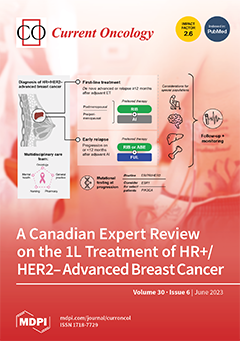Background: Radiation therapy (RT) is an established palliative treatment for bone metastases; however, little is known about post-radiation survival and factors which impact it. The aim of this study was to assess a population-based sample of metastatic prostate cancer patients receiving palliative radiation
[...] Read more.
Background: Radiation therapy (RT) is an established palliative treatment for bone metastases; however, little is known about post-radiation survival and factors which impact it. The aim of this study was to assess a population-based sample of metastatic prostate cancer patients receiving palliative radiation therapy to bone metastases and contemporary palliative systemic therapy and identify factors that impact long-term survival. Materials/methods: This retrospective, population-based, cohort study assessed all prostate cancer patients receiving palliative RT for bone metastases at a Canadian provincial Cancer program during a contemporary time period. Baseline patient, disease, and treatment characteristics were extracted from the provincial medical physics databases and the electronic medical record. Post-RT Survival intervals were defined as the time interval from the first fraction of palliative RT to death from any cause or date of the last known follow-up. The median survival of the cohort was used to dichotomize the cohort into short- and long-term survivors following RT. Univariable and multivariable hazard regression analyses were performed to identify variables associated with post-RT survival. Results: From 1 January 2018 until 31 December 2019, 545 palliative RT courses for bone metastases were delivered to
n = 274 metastatic prostate cancer patients with a median age of 76 yrs (Interquartile range (IQR) 39–83) and a median follow-up of 10.6 months (range 0.2 to 47.9). The median survival of the cohort was 10.6 months (IQR 3.5–25 months). The ECOG performance status of the whole cohort was ≤2 in
n = 200 (73%) and 3–4 in
n = 67 (24.5%). The most commonly treated sites of bone metastasis were the pelvis and lower extremities
n = 130 (47.4%), skull and spine
n = 114 (41.6%), and chest and upper extremities
n = 30 (10.9%). Most patients had CHAARTED high volume disease
n = 239 (87.2%). On multivariable hazard regression analysis, an ECOG performance status of 3–4 (
p = 0.02), CHAARTED high volume disease burden (
p = 0.023), and non-receipt of systemic therapy (
p = 0.006) were significantly associated with worse post-RT survival. Conclusion: Amongst metastatic prostate cancer patients treated with palliative radiotherapy to bone metastases and modern palliative systemic therapies, ECOG performance status, CHAARTED metastatic disease burden, and type of first-line palliative systemic therapy were significantly associated with post-RT survival durations.
Full article






